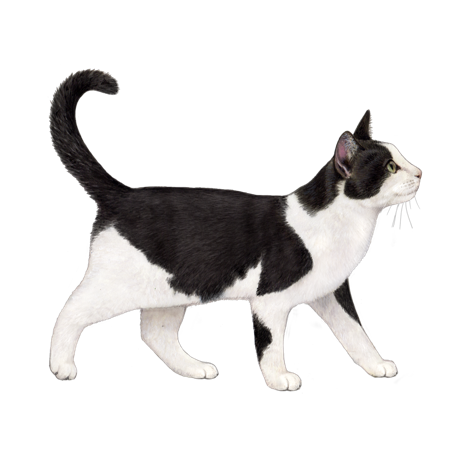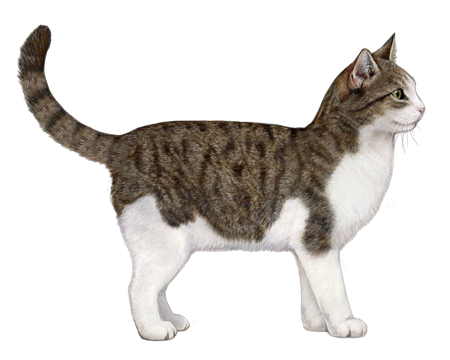
American Bobtail
American Bobtails have a wild cat appearance and affectionate personality. They are a devoted, playful breed that can provide both entertainment and emotional support.
Interested in discovering if your cat is an American Bobtail?
Check out Wisdom Panel's DNA test.
American Bobtail Traits
General Appearance
The American Bobtail is a medium-to-large cat with a naturally short tail. They have an athletic, muscular build and a hunter's gaze that give the breed a wild cat appearance.
Coat and Colouring
American Bobtails come in both longhaired and shorthaired varieties. But the shorthaired's coat is actually medium-length. It's also a double coat—with a hard topcoat and soft, downy undercoat.
Longhaired Bobtails have medium-long, slightly shaggy hair that's somewhat longer on the ruff, britches, belly, and tail. They have a double coat, as well, though the undercoat is not very dense.
Both Bobtail types come in all colors and patterns.
Distinctive Physical Traits
American Bobtails have a wedge-shaped head, prominent cheekbones, and distinctive brow. Their large, almond-shaped eyes come in all colors. Their ears are medium-sized, with a wide base and rounded tips. (Many Bobtails also have ear furnishings.) And their most notable feature, of course, is a bobbed tail—which is broad at the base and long enough to be visible above the back when alert.
American Bobtail Temperament
American Bobtails are friendly, engaging cats that form tight bonds with their humans. They typically get along with kids and dogs and are eager to greet visitors.
Affectionate and devoted (without being needy), Bobtails like to be near their people but aren't overly demanding of attention. They're also generally quiet—communicating mostly through soft trills or chirps.
Both athletic and playful, the Bobtail is always up for some fun. Their favorite activities often include games of fetch, hide-and-seek, and strolling through the neighborhood on a leash. They also enjoy showing off their innate hunting skills by stalking, pouncing, or capturing a fly in mid-air.
Thanks to their easy-going nature and clown-like antics, Bobtails make excellent therapy cats capable of brightening anybody's day.
American Bobtail History
The American Bobtail developed through natural selection for decades before a formal breeding program launched in the late 1960s. Detailed information about the American Bobtail's earliest years is lacking. But breeders initially used cats with naturally occurring bobbed tails as the breed's foundation stock. Many people believe a cat named Yodi is the patriarch of the American Bobtail.
A couple traveling through Arizona found Yodi— a tabby cat with a short tail—on a Native American Reservation. They decided to keep him and brought him home to Iowa. Yodi and the couple's female cat mated, producing a litter of short-tailed kittens. Those kittens were crossed with a longhaired color point cat, creating (potentially) the first true American Bobtails.
Today, both the Cat Fanciers Association and The International Cat Association recognize the American Bobtail.
American Bobtail Care
Nutrition
Bobtails require a high-quality diet. Because nutritional needs vary for kittens, adults, and senior cats, opt for a formula that's age-appropriate for your pet.
To keep your cat at a healthy weight, measure out meals and reduce portions if necessary. And don't forget to account for calories from treats in their daily totals. As a guideline, treats should make up no more than 10% of a cat's calories.
Finally, all cats need access to fresh, clean water at all times.
Grooming
Both longhaired and shorthaired Bobtails are relatively easy to groom. For most of the year, brushing them once or twice a week is enough to remove loose hair and—in the case of the longhaired cats—prevent tangles. During periods of seasonal shedding, you may need to brush more frequently.
Most cats' nails require monthly trimming to prevent them from getting too long. Long nails are more likely to snag on something and become torn or damaged. They can even grow into your cat's paw pads, leading to pain or infection. In addition to clipping, providing a scratching post will allow your cat to do some nail maintenance themselves (thanks to their instinct to scratch).
Dental hygiene is another essential component of your cat's care. Beginning in kittenhood, start your Bobtail on a routine that includes at-home teeth brushing and regular visits to the veterinarian for professional dental cleanings and exams.
Health
Roughly one out of every three cats in the United States is overweight or obese. And those extra pounds can contribute to other health risks—such as arthritis, diabetes, and heart problems. Your veterinarian is the best resource for tips on managing your cat's weight.
Breed Group
Western
The largest of breed groups, the Western Group is mainly comprised of cats developed in Europe and the Americas. Due to the complexity of feline genetic diversity, however, cat breeds from other regions may also be found associated with this group.
Resources
https://cfa.org/american-bobtail/
https://cfa.org/wp-content/uploads/2019/06/american-bobtail-standard.pdf
https://tica.org/breeds/browse-all-breeds?view=article&id=815:american-bobtail-breed&catid=79
https://www.worldcatcongress.org/wp/cat_breed_comp_abs.php
https://vcahospitals.com/know-your-pet/cat-breeds/american-bobtail
https://www.banfield.com/state-of-pet-health/obesity
Reviewed 23 February 2021 by Annette Louviere, DVM


























